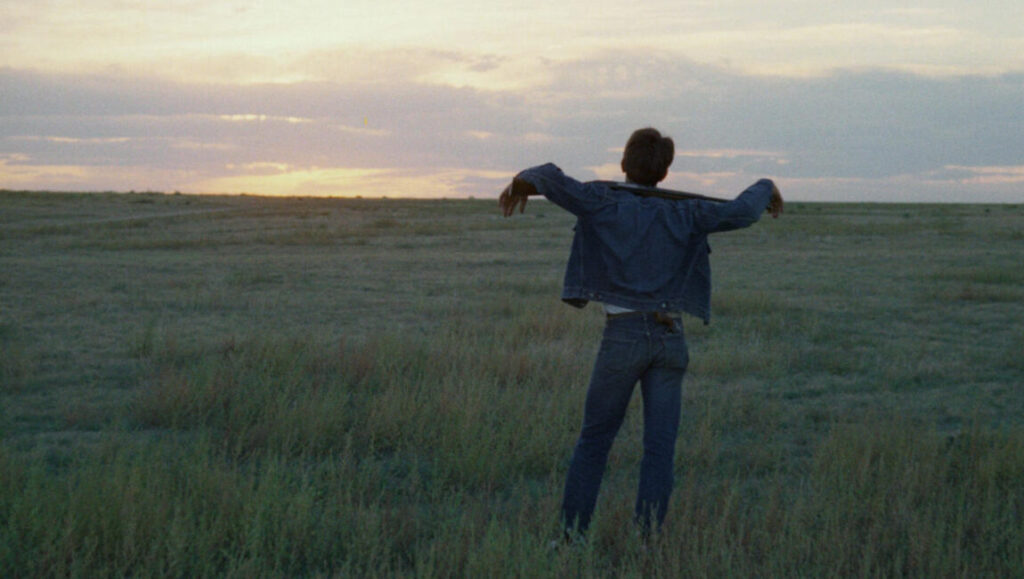Over a decade before the Coen Brothers released their neo-noir, blood-soaked vision of Americana, Blood Simple, Terrence Malick’s Badlands etched into the public consciousness a particularly languid flavor of Midwestern cruelty. Loosely based on the true story of Charles Starkweather and Caril Ann Fugate’s 1958 killing spree, Badlands stars Martin Sheen as Kit, a trigger-happy ex-laborer who tears across the South Dakota and Montana badlands with his underage girlfriend Holly, played by perennial naif Sissy Spacek. Prior to this debut, which closed the 1973 New York Film Festival, Malick had to his credit a single short film and a number of screenplays. With Badlands, Malick has crafted is a film that fuses his technical and visual trademarks, seen here in their infancy, with the mythology of the American west. He carries forth the lineage of hardscrabble frontiersmen, complete with gangs of bounty hunters and tales of lost Spanish coins, and in doing so updates classic American fables such as Huckleberry Finn and Swiss Family Robinson. Malick cites these stories as his inspiration for Badlands, however unconscious, and distills their central conceit as “an innocent in a drama over his or her head.” It’s easy to slot Holly into this role – Sissy Spacek’s huge green eyes simply demand it – but the same is true for “hellbent type” Kit, the wannabe James Dean. He’s guileless enough to admit that he always wanted to be a criminal, “just not this big a one”, and narcissistic enough to spend his final moments of freedom enshrining the spot of his capture with a stone cairn. Long, serene shots of animals and landscape, with the duo’s stolen Cadillac a mere speck hurtling through unfenced prairie, convey the American West’s fatal, intoxicating blend of fearlessness and romance, cut with a near-mystical faith in one’s own place in the world. Yet there’s something rotten at the core of Malick’s vision. Early in their fugitive days, Kit and Holly forge a ramshackle existence in a grove of cottonwoods and spend their time catching fish, creating homemade booby traps, and lounging atop wooden ladders in dappled sunlight. It’s an improbably pre-lapsarian sort of existence for those tainted by the cardinal sin of murder. But this idyllic lifestyle is a condition of fear rather than freedom, and their very ingenuity is what triggers another string of murders.
Long, serene shots of animals and landscape, with the duo’s stolen Cadillac a mere speck hurtling through unfenced prairie, convey the American West’s fatal, intoxicating blend of fearlessness and romance, cut with a near-mystical faith in one’s own place in the world. Yet there’s something rotten at the core of Malick’s vision
Like Peter Weir’s Picnic at Hanging Rock, another 70’s cut that evokes the peculiar temporal mythology, Badlands is arguably more concerned with tone than plot. Even as the body count mounts, the movie is languorous to the point of bordering on desultory. Throughout the film, Holly’s flat and expressionless voiceover acts as something far more unusual than the typical audience surrogate. Malick contrives for her to consistently know less than the audience, and in doing so, fashions a disconcertingly unreliable narrator from an unexpected source. The emotions we, the viewers, are invited to feel – horror at the increasingly senseless killings, or disgust at Kit’s cavalier attitude – seem absent in her. At the eleventh hour, she explains to a disbelieving Kit that she won’t go with him, for no other reason that that she just doesn’t want to. Malick’s genius is to create a thriller with so little urgency, it’s frozen in time. Like an insect in amber, Badlands captures a single moment that comes to define an era. The film’s stakes, which should reasonably surge to a fever pitch (as demonstrated by the climactic manhunt in Ridley Scott’s indomitable Thelma & Louise), barely rise to the level of life, much less life versus death. People are killed and spared on a momentary whim; executions are glossed over in mechanical monotone. For Kit and Holly, whose depth of understanding skim along the shallow, bright surface of things, capture is an inconvenience. Even in chains, it seems important to make the best of things. The movie’s final shot, of sunshine and clouds as seen from the airplane that carries them to their destiny, is a culmination of Malick’s vision: a declaration that the elemental horrors of human nature, can, despite everything, coexist with the numinous, tender miracle of simply being alive at all.
Part of Kicking the Canon – The Film Canon.


Comments are closed.